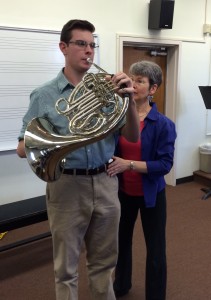 Frequently Asked Questions:
Frequently Asked Questions:
- How many lessons do I need?
- Who can benefit from the Alexander Technique?
- How does it apply to various conditions?
- Who was F.M. Alexander?
- Are there books I can read?
- What kind of training do teachers have?
- Who are some famous students?
- Are there institutions that include AT in their curriculum?
How many lessons do I need?
The number of lessons you need will depend on your condition and goals. Some students take lessons for a few months, while others will choose to study on an on-going basis. After 2 or 3 lessons you’ll know if the Technique is right for you. After 10 or 20 lessons you’ll have a clearer sense of the long-term benefits of the work.
The most lasting changes will happen with a commitment of 30 lessons. Students often choose to take several lessons a week at the beginning, and will gradually space their lessons farther apart. While it is optimal to get frequent lessons early on, you will choose what works for you. I do offer a discount for students who take more than one lesson per week.
Who can benefit from the Alexander Technique?
Performing artists, athletes and equestrians.
People with chronic pain.
People coping with high stress and / or anxiety.
People who want to improve their posture, move easily and age vibrantly.
Seekers of better and more mindful ways of living.
How does it apply to various conditions?
See Resources page.
Please note: AT teachers are not doctors, and do not diagnose, treat or cure.
Who was F.M. Alexander?
F.M. Alexander (1869-1955) was a young Australian actor who suffered from recurrent voice loss on stage. When doctors were unable to help him, he set out to help himself, with the aid of several mirrors and a great deal of patient observation. He discovered that as he would begin to speak, he would massively tighten his whole body, most notably compressing his head into his spine, shortening his spine and constricting his larynx. After much experimentation, he discovered that changing the way he thought before he spoke could prevent this pattern of over-tensing, allowing his head to balance freely over his spine and his spine to lengthen upward. He also noticed great improvement in his breathing, posture and overall coordination. His voice recovered completely and improved dramatically, and he began teaching others how to understand the link between their own thinking and coordination. He developed a highly sophisticated way of conveying a new experience to students with his hands, helping them to identify their own tensing habits and to find a new sense of ease and balance. He took his work to London and received great acclaim from the performing arts and medical communities there. Later in his life, he began training teachers to carry on his work, and there are now several thousand teachers world-wide.
Are there books I can read?
The following books can all be ordered from: AmSAT Books: 800 473 0620 or info@amsatonline.org.
You can view the entire catalogue at: www.amsat.ws/books
Here are some of my favorites:
- How You Stand, How You Move, How You Live by Missy Vineyard
- The Posture Workbook and Body, Breath and Being by Carolyn Nicholls
- Body Learning by Michael Gelb
- The Alexander Technique: A Skill for Life by Pedro de Alcantara
- Indirect Procedures: A Musician’s Guide to the A.T. by Pedro de Alcantara
- The Alexander Technique for Musicians by Kleinman and Buckoke
- The Use of the Self by F.M. Alexander
- Freedom to Change by Frank Pierce Jones
- Voice and the Alexander Technique by Jane R. Heirich
- Physical Expression on Stage and Screen by Bill Connington
- Mind and Muscle by Elizabeth Langford
- Living the Alexander Technique by Ruth Rootberg
- Bodysense by Sally Tottle (for riders)
What kind of training do teachers have?
Certified teachers of the Alexander Technique have completed a teacher training program of 1600 hours of class instruction over a minimum of three academic years with a student/teacher ratio no greater than five-to-one. AmSAT (American Society for the Alexander Technique) maintains the nation’s highest standards for teacher training, certification and membership and maintains affiliations with similar credentialing bodies worldwide. In the US there are twenty AmSAT-approved teacher-training programs in ten states and dozens of programs certified by affiliated societies in countries around the world. Board-approved AmSAT teacher training courses meet the requirements of the Training Approval Committee which periodically reevaluates each of AmSAT’s teacher training programs and its directors. There are over 600 AmSAT certified teachers nationwide.
Who are some famous students?
Students of the Technique include this short list of luminaries:
Actors Judi Dench, Kenneth Branagh, Maggie Smith, Robin Williams, John Cleese, Annette Bening, Lupita N’yongo and Kevin Kline, musicians Paul McCartney, Yehudi Menuhin and Sting, soprano Renee Fleming, conductors Sir Colin Davis and Sir Adrian Boult, dancer/choreographer Trisha Brown, equestrienne Sally Smith, scientist Raymond Dart, authors Aldous Huxley, George Bernard Shaw and Robertson Davies, and philosopher/educator John Dewey.
“The Technique’s many benefits include minimized tension…mind/body connection…and an inch and a half of additional height!” —Kevin Kline, actor
Are there educational institutions that offer the Technique in their curriculum?
The Aspen Music Festival, The American Dance Festival, The American Conservatory Theater, The Juilliard School, Royal Academy of Dramatic Arts, Los Angeles Philharmonic Institute, New York University, Boston College, Boston University, The Acting Studio (NY), New England Conservatory, Yale School of Drama. There are many more; the list grows ever longer!
Schedule a lesson:
Tully@alexandertechtully.com
703-554-4468
